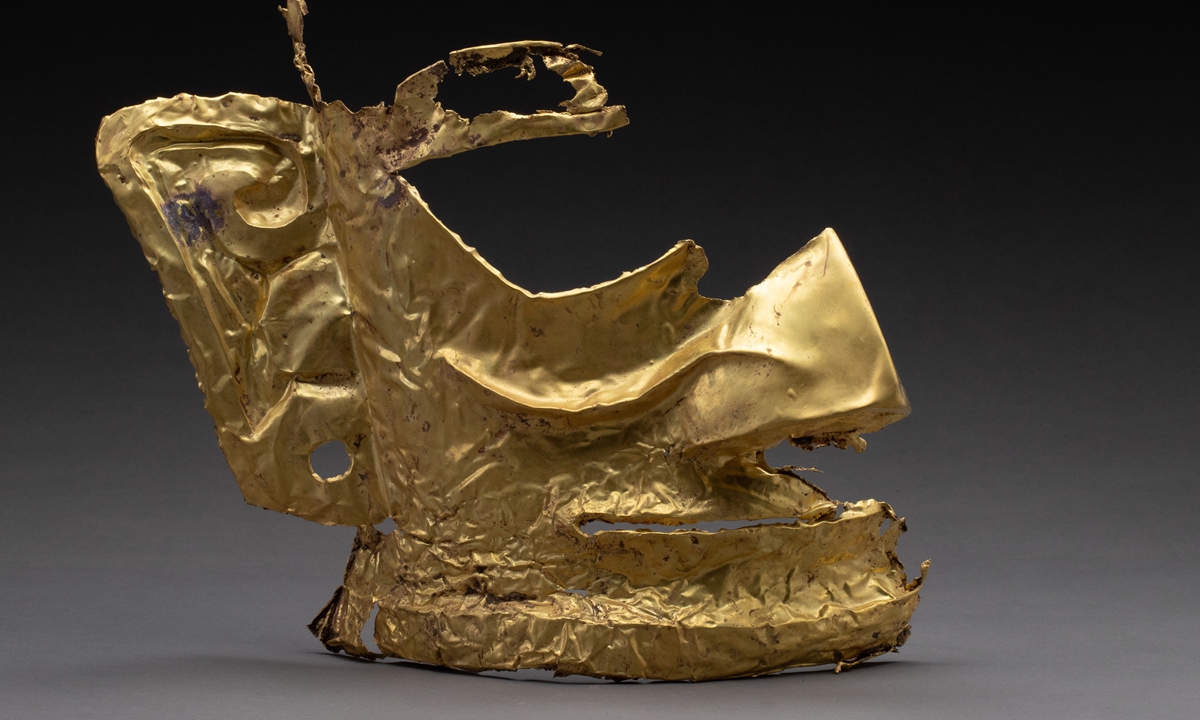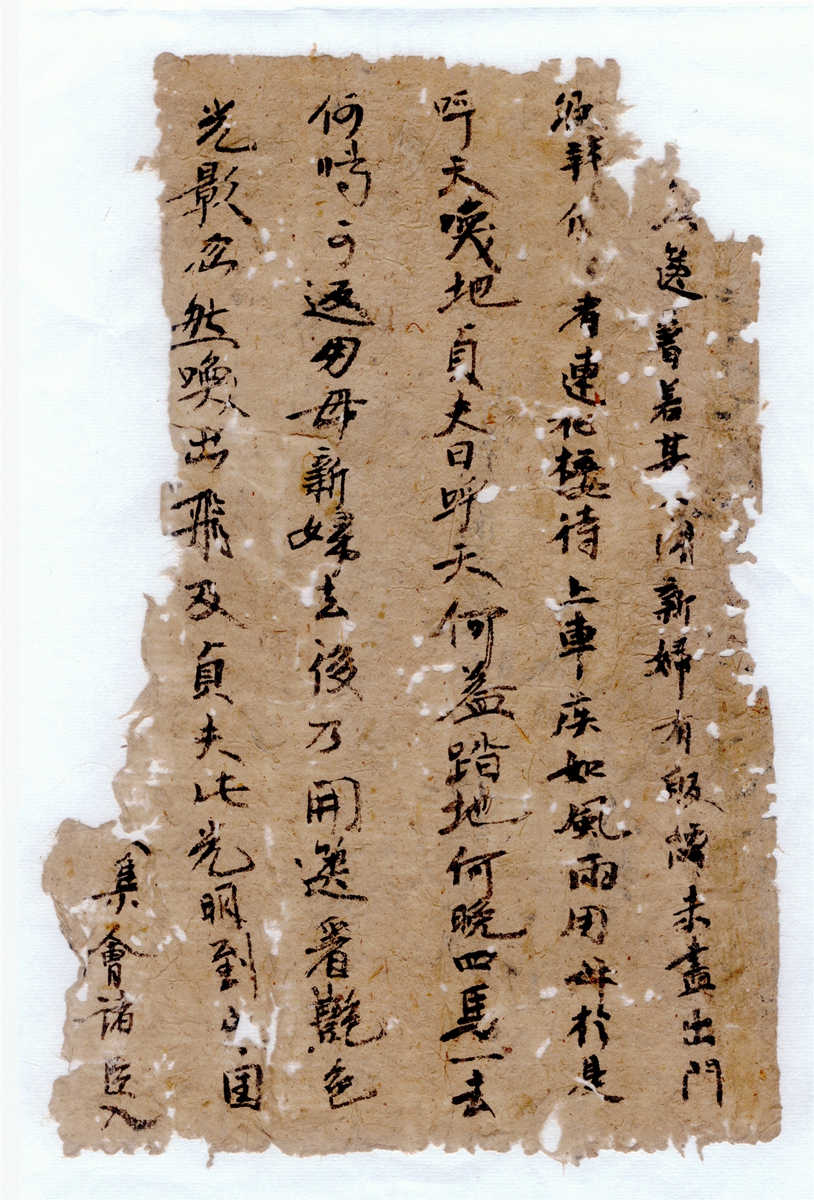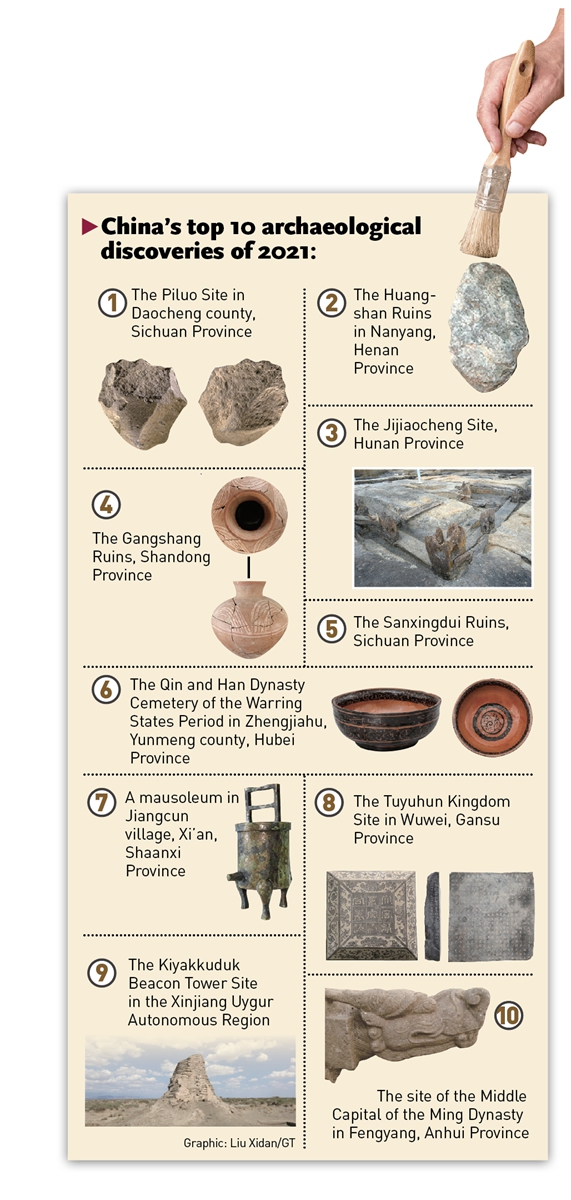
Above: An incomplete gold mask unearthed from the Sangxingdui Ruins Photo: Courtesy of China's National Cultural Heritage Administration

A paper document unearthed from the Kiyakkuduk Beacon Tower Site in Xinjiang Uygur Autonomous Region Photos: Courtesy of China's National Cultural Heritage Administration
China's National Cultural Heritage Administration (NCHA) on Thursday revealed the country's top 10 archaeological discoveries of 2021, a year that marked the centennial of the birth of modern Chinese archaeology. The 10 outstanding discoveries are the highlights of 32 archaeological projects covering the origin of early human beings, the development of prehistoric culture as well as the historical processes that unified China into a multi-ethnic civilization.
According to NCHA, it is working to implement the 14th Five-Year Plan for Archaeological Work, which includes promoting the application of modern science and technology in archaeology and deepening international archaeological cooperation and exchanges.
The Piluo Site in Daocheng county, Southwest China's Sichuan Province is a large-scale Paleolithic site that can be traced back to more than 130,000 years ago. More than 6,000 relics, including Acheulean handaxes similar to those found in prehistoric sites across Africa and the western coast of the Eurasian continent, have been discovered at the site. The site proves that ancient humans climbed up to the Qinghai-Xizang Plateau, the average altitude of which is about 3,750 meters above sea level, more than 100,000 years ago.
The Huangshan Ruins in Nanyang, Central China's Henan Province encompasses three Neolithic cultures - the early Yangshao culture (5000BC to 3000BC), the Qujialing culture (3300BC to 2600BC) and the Shijiahe culture (3000BC to 1900BC). The discoveries at the site reflect the complexity of the society and the cultural exchanges between the northern and southern regions of China.
The Jijiaocheng Site, a Neolithic period site in Central China's Hunan Province, was a city during the Qujialing culture period. More than 30 housing sites, including wooden buildings that date back as far as 4,800 years ago, were discovered within the 721-square-meter site. Experts say the discovery has furthered research into the overall architectural styles of the Yangtze River Basin.
The Gangshang Ruins in East China's Shandong Province are the largest prehistoric city site from the Dawenkou culture period (4000BC- 2600BC). Experts say the unearthed relics provide solid evidence of Chinese civilization's 5,000-year-long history.
The Sanxingdui Ruins in Sichuan Province, one of the most well-known archaeological sites of 2021, was contemporaneous with the Shang Dynasty (c.1600BC-1046BC). Tang Fei, dean of the Sichuan Provincial Cultural Relics and Archeology Research Institute, told the Global Times on Thursday that archaeologists will continue focusing on the excavation of remains in sacrificial pits in 2022. Relics unearthed from the site so far include bronze wares and silk fabrics that demonstrate that the ancient Shu civilization is an important part of Chinese civilization.
Excavations at the Qin and Han Dynasty Cemetery of the Warring States Period (475BC-221BC) in Zhengjiahu, Yunmeng county, Central China's Hubei Province have produced rare burial paintings dating from the end of the Warring States Period to the Qin and Han dynasties (221BC-220). The paintings, most of which cover themes that have not been seen in other works from the period, fill a historical gap when it comes to the materials used during this time period.
A large-scale mausoleum located in Jiangcun village in Xi'an, Northwest China's Shaanxi Province has been identified as belonging to Emperor Wendi of the Western Han Dynasty (206 BC-AD 25). Its construction adopts the same emperor-centric design concept used by later imperial mausoleums.
The Tuyuhun Kingdom (417-688) Site at Wuwei, Northwest China's Gansu Province contains a group of tombs for members of the royal family of the Tang Dynasty (618-907). The site shows that the emperors of the Tang Dynasty unified multi-ethnic groups and is an example of their frequent cultural communication. It is also of great significance to the study of the ancient Silk Road.
The Kiyakkuduk Beacon Tower Site in Northwest China's Xinjiang Uygur Autonomous Region was used to transmit military smoke and fire signals during the Tang Dynasty. Archaeologists have unearthed more than 700 wooden tablets and paper documents, most of which are records from the Tang Dynasty that demonstrate the Tang Dynasty's effective control over the Western Regions.
Starting construction in 1369, the Middle Capital of the Ming Dynasty (1368-1644) in Fengyang, East China's Anhui Province took 1 million workers six years to complete. Fengyang is the birthplace of the first emperor of the Ming Dynasty Zhu Yuanzhang. The palace is 840,000 square meters in size, 120,000 square meters larger than the Forbidden City in Beijing and provides valuable insight for research on ancient capitals in China.







